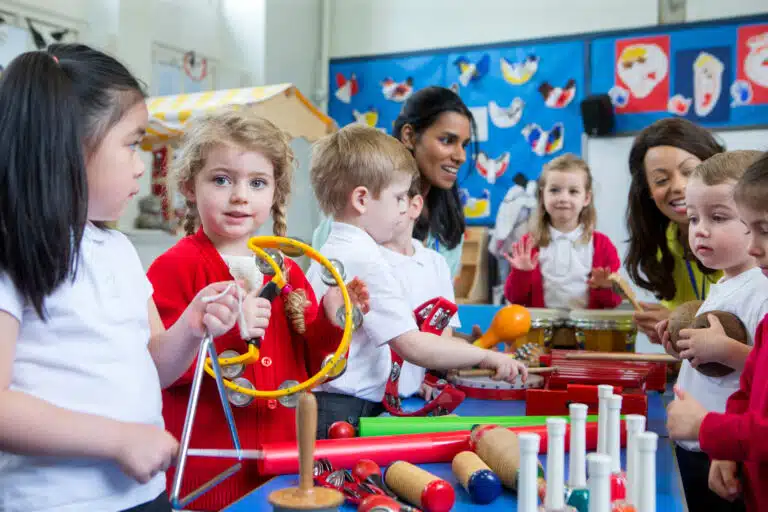
From the moment they take their first steps into the world, toddlers are navigating a complex landscape of emotions and it can seem daunting to teach emotions to this age group.
With their burgeoning curiosity, growing independence and expanding social interactions, these little ones are confronted with a multitude of feelings that can be overwhelming to comprehend and express.
As early childhood educators, it is your responsibility to provide them with the necessary tools to navigate and understand this emotional landscape.
Children with higher emotional intelligence are better able to pay attention, are more engaged in school, have more positive relationships and are more empathic, according to the National Association for the Education of Young Children.
The ability to identify, understand and manage emotions not only promotes healthy social and emotional well-being but also establishes a strong foundation for building meaningful relationships, effective communication and resilience throughout their lives.
Let’s take a look at five ways to teach emotions to preschoolers and help support their emotional development.
1. Bring on the Puppets
Puppets are among the most tried and true props for emotion-related activities for toddlers.
Start your class with a lesson on the different emotions people experience and have your students reflect on each. Also, introduce your students to the concept that people can feel more than one at a time and, while that’s completely normal, it’s important to ensure you’re in control of them. Then have your students use various craft materials to create a puppet that showcases an emotion of their choice.
Once they’ve designed them, invite the kids to share their puppet with the group before storing them in a large, easy-to-access box. As the days go on, let students know they can come back to the box and use the appropriate puppets any time they need to sort out a feeling.
2. Get Emotional at Storytime

One of the easiest methods of teaching emotions to preschoolers is through stories. Commit to selecting one week each month (or one day each week) to read stories that focus on social-emotional skills. As you read through them, talk with your students and have them discuss with each other about what they learned in the book and how the main character demonstrated various feelings.
For an added bonus, have students act out what the prominent emotions were in the book.
3. Break out in Song
Studies have shown that students remember concepts better when they’re accompanied by music. So try teaching music in your classroom as a way of teaching emotions to preschoolers.
Work with your students to memorize the lyrics. Once you’ve finished a song, have students share how the song makes them feel or what they think they should take away from it. Find easy-to-learn instruments for your students to play with the music and put on a concert for parents where they can show off their new skills!

4. Move, Match and Memorize
Help your toddlers learn what emotions can look like with this fun and free Monster Feeling game from Pocket of Preschool. Before the game begins, show your students each monster, read through the emotion and have them practice showing the emotion themselves. Then, pass out the cards and tell each student to keep their card a secret, while also walking around making the face shown on it. Once they find someone making a similar face, ask them to show their cards to see if they’ve got a perfect match. Once the activity is over, have the students reflect on a time when they felt their card’s emotion — and how they could show that in the future.
5. Create Calm-Down Kits
Emotional regulation can be a difficult topic to introduce to preschoolers, but these calm down kits from Autism Adventures are a great resource to start with. Calm-down kits are great because they can be customizable based on your supplies and students and can be managed at a student level or on a classroom level.
Include toys that can help your student re-center and focus (like bubbles or another sensory activity), along with place cards and notebooks to help them recognize and speak about their emotions.
How Vine Assessments Can Help!

Teaching emotions to preschoolers is a fundamental aspect of nurturing their emotional intelligence. It involves guiding them in recognizing and labeling their feelings, empathizing with others and developing healthy coping mechanisms. By empowering toddlers with this essential skillset, you can lay the groundwork for a lifetime of emotional intelligence and well-being.
Doing regular assessments to make sure that toddlers, as well as other children in your preschool, is vital.
Vine Assessments gives early childhood educators and staff a way to clearly articulate the growth and development of children in their care, and it’s integrated into Procare at no cost to users!
These assessments align with standards in all 50 states and offer a unique framework that makes it easy to use and understand for both parents and teachers.
While many assessment frameworks use vague wording and generic terms that can be loosely associated with a developmental milestone, Vine Assessments provides granular, clearly worded indicators that make assessments quick and painless.
Learn more about how Vine Assessments can benefit your daycare and the children you serve!


